Note:
Antelope Island State Park used to be one of my favorite locations in northern Utah. Due to pipeline construction along the causeway to the island, construction on the island itself, plus areas that were birdy being restricted now, and negative impacts caused by climate change, I truthfully can’t say that anymore. Your preferences may vary.
This is the third post in my series about Wild and Wonderful Antelope Island State Park, I’ve saved the best (and longest) for last. The Birds! Okay, maybe they aren’t the best thing about Antelope Island State Park, but I am a bird photographer and they are what I am most passionate about!
Birds of Antelope Island:
Before I get to the avian life of the island I’d like to provide a link from UtahBirds.org that has a checklist of the birds of Antelope Island that is downloadable. If you need ID help for the birds found on the island UtahBirds.org has a great photo gallery of the various species put together by the wonderful Milt Moody that are contributed by local bird photographers that can assist in ID.
Upland Game Birds:
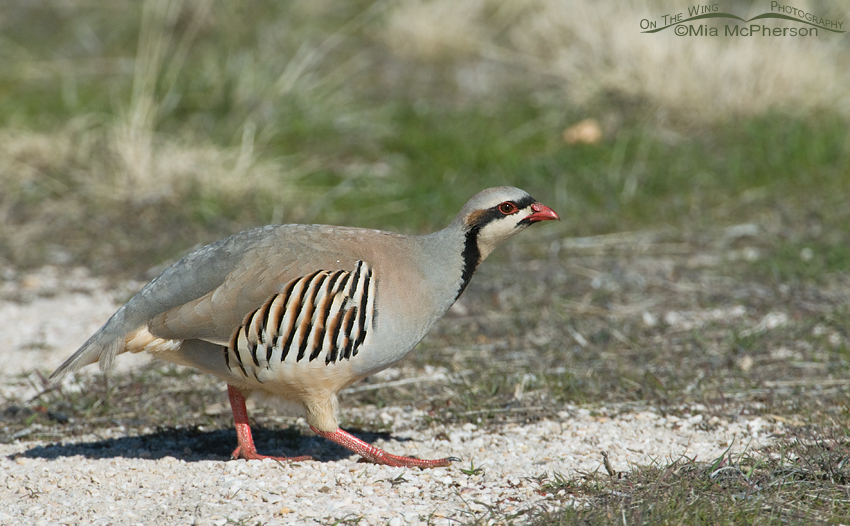 Feeding Chukar (Alectoris chukar) – Nikon D200, f8, 1/1250, ISO 400, Nikkor 200-400mm VR with 1.4x TC at 400mm
Feeding Chukar (Alectoris chukar) – Nikon D200, f8, 1/1250, ISO 400, Nikkor 200-400mm VR with 1.4x TC at 400mm
Chukars are the most visible of the upland game birds that inhabit the island, they do not migrate so they can be seen all year round. Although they are not native to North America the Chukars on Antelope Island have adapted well to their adopted home. My first sighting of a Chukar in the wild was on Antelope Island and I am still as thrilled today to photograph them as I was on my first to the island.
Other upland game birds that can be seen on the island are Ring-necked Pheasants, California Quail and I’ve seen Sharp-tailed Grouse there as well. Thankfully the birds on Antelope Island are not hunted.
Gulls:
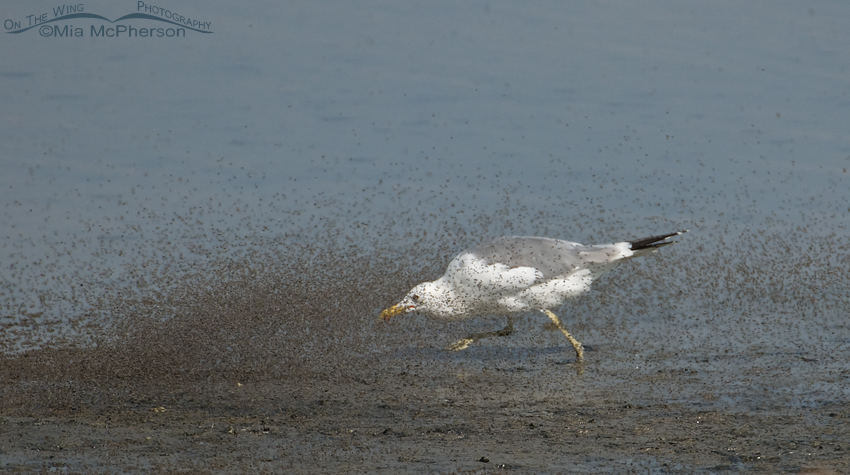 California Gull (Larus californicus) chasing brine flies – Nikon D200, f6.3, 1/1500, ISO 250, Nikkor 200-400mm VR with 1.4x TC at 400mm
California Gull (Larus californicus) chasing brine flies – Nikon D200, f6.3, 1/1500, ISO 250, Nikkor 200-400mm VR with 1.4x TC at 400mm
The Great Salt Lake and its surrounding marshes are a magnet for birds like gulls and terns. The Utah State Bird is the California Gull and it is often visible along the causeway to the island, the shoreline, in flight over the island and can also be found perched on the pavilions near the campgrounds and the Buffalo Grill.
I believe that although gulls are common they can be uncommonly beautiful photographed in the right light, in a great pose or interesting habitat.
Shorebirds:
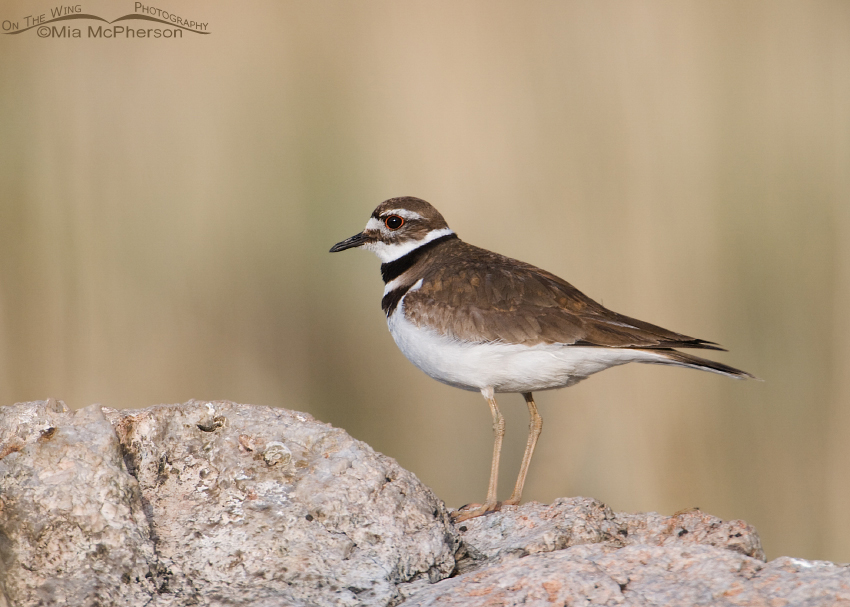 Killdeer (Charadrius vociferous) on a rock – Nikon D200, f6.3, 1/320, ISO 400, Nikkor 200-400mm VR with 1.4x TC at 400mm
Killdeer (Charadrius vociferous) on a rock – Nikon D200, f6.3, 1/320, ISO 400, Nikkor 200-400mm VR with 1.4x TC at 400mm
There are many shorebirds that visit Antelope Island, the causeway to the island and the surrounding freshwater marshes, too many for me to post an image of each one so I will just post a few. I counted 35 on the checklist but some of those are rare vagrants, still that is a lot!
Some of the shorebirds are just passing through the Salt Lake Valley during their migration further north to their breeding ground, the Killdeer pictured above nests on the island along with several other species.
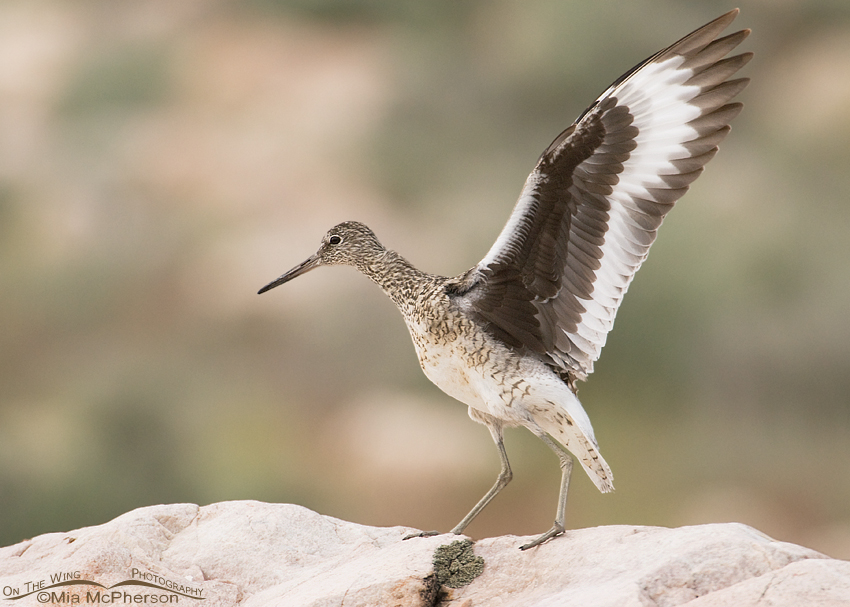 Willet (Tringa semipalmata) wing lift – Nikon D200, f7.1, 1/750, ISO 400, 200-400mm VR with 1.4x TC at 400mm
Willet (Tringa semipalmata) wing lift – Nikon D200, f7.1, 1/750, ISO 400, 200-400mm VR with 1.4x TC at 400mm
Willets are another species of the shorebirds that nest on the island, prior to breeding season they can be seen quite often along the causeway but when they are nesting they can be seen in the grasses and on the rocks along the road. They let their presence be known by loud calling and wing displays. The bird above was displaying because another Willet was nearby and they don’t seem to care for intruders on their territory.
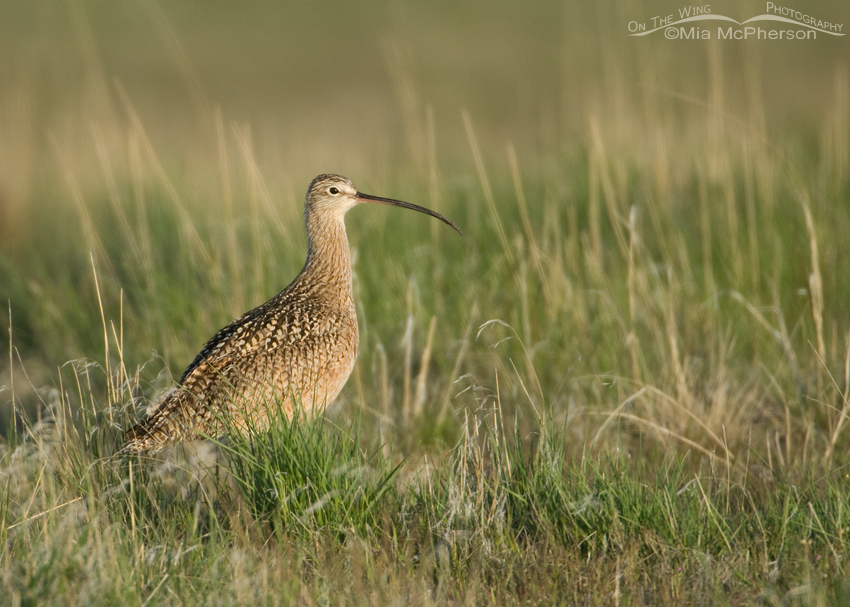 Male Long-billed Curlew (Numenius americanus) – Nikon D200, f5.6, 1/640, ISO 400, Nikkor 200-400mm VR with 1.4x TC at 400mm
Male Long-billed Curlew (Numenius americanus) – Nikon D200, f5.6, 1/640, ISO 400, Nikkor 200-400mm VR with 1.4x TC at 400mm
It won’t be very much longer before the Long-billed Curlews return to nest on Antelope Island and until I can hear their hauntingly beautiful calls. In Florida I never heard the calls of these graceful shorebirds, it is call that once you hear it, you’ll never forget it. I am very much looking forward to their return.
In the summer the calls of American Avocets and Black-necked Stilts can easily be heard along the causeway and their numbers are in the thousands (and thousands). There are just so many shorebirds present at times I can’t post a photo of them all but the checklist I linked to above shows all of the species.
Perching Birds:
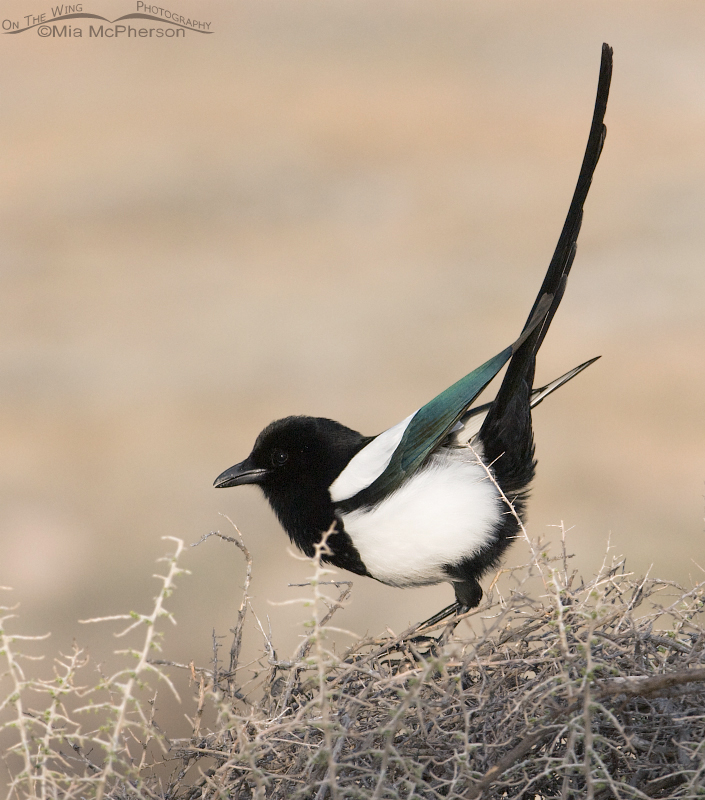 Black-billed Magpie (Pica hudsonia) on nest – Nikon D200, f6.3, 1/640, ISO 500, +1.0 EV, Nikkor 200-400mm VR at 380mm
Black-billed Magpie (Pica hudsonia) on nest – Nikon D200, f6.3, 1/640, ISO 500, +1.0 EV, Nikkor 200-400mm VR at 380mm
There are also more perching birds on the island than I can list, I didn’t even try to count them so I’ll just post some images of the ones I see often like this Black-billed Magpie on top of its nest. Black-billed Magpies are great fun to observe and photograph at any time of the year. Some people call them noisy but as a bird lover their raucous calls are music to my ears.
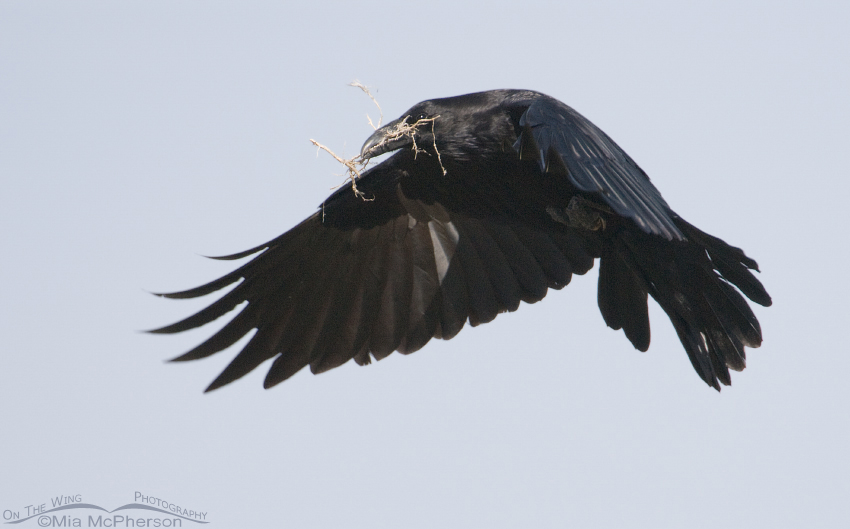 Common Raven (Corvus corax) with nesting material – Nikon D200, f6.3, 1/1500, ISO 400, +0.7 EV, Nikkor 200-400mm VR with 1.4x TC at 400mm
Common Raven (Corvus corax) with nesting material – Nikon D200, f6.3, 1/1500, ISO 400, +0.7 EV, Nikkor 200-400mm VR with 1.4x TC at 400mm
Common Ravens are in the Jay, Crow and Allies family along with the Black-billed Magpies and they are among the smartest birds in the world. They can bee seen flying all over Antelope Island, on the ground, perched on bushes or harassing other birds and animals. Just yesterday alone I saw them harassing Northern Harriers, a lone Coyote on a hill and a Rough-legged Hawk. Feisty and fun!
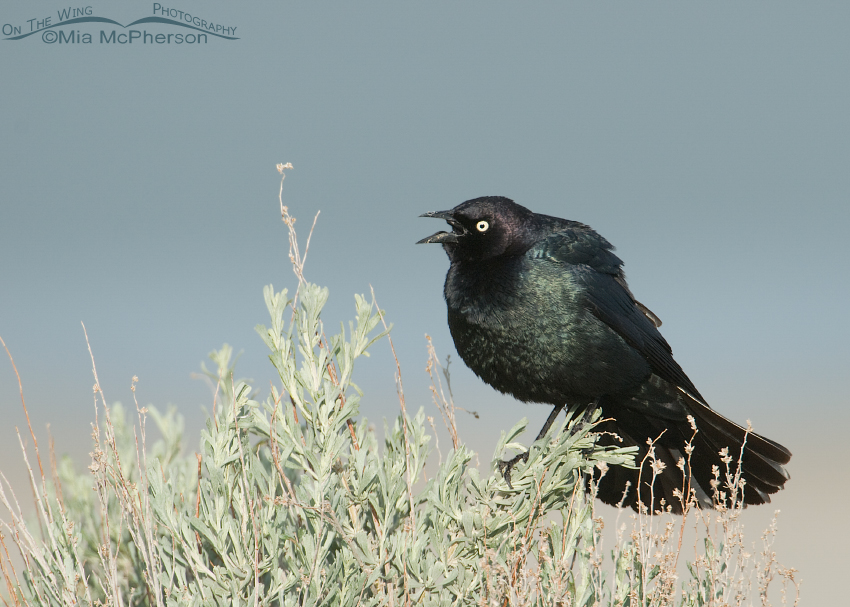 Male Brewer’s Blackbird (Euphagus cyanocephalus) displaying on sagebrush – Nikon D200, f7.1, 1/500, ISO 400, Nikkor 200-400mm VR with 1.4x TC at 400mm
Male Brewer’s Blackbird (Euphagus cyanocephalus) displaying on sagebrush – Nikon D200, f7.1, 1/500, ISO 400, Nikkor 200-400mm VR with 1.4x TC at 400mm
There are several different species of Blackbirds present on the island which include Brewer’s Blackbirds, the bird above is displaying for a female who was just outside of this frame. I love the beautiful iridescence that can been seen in their plumage when the light is at the right angle.
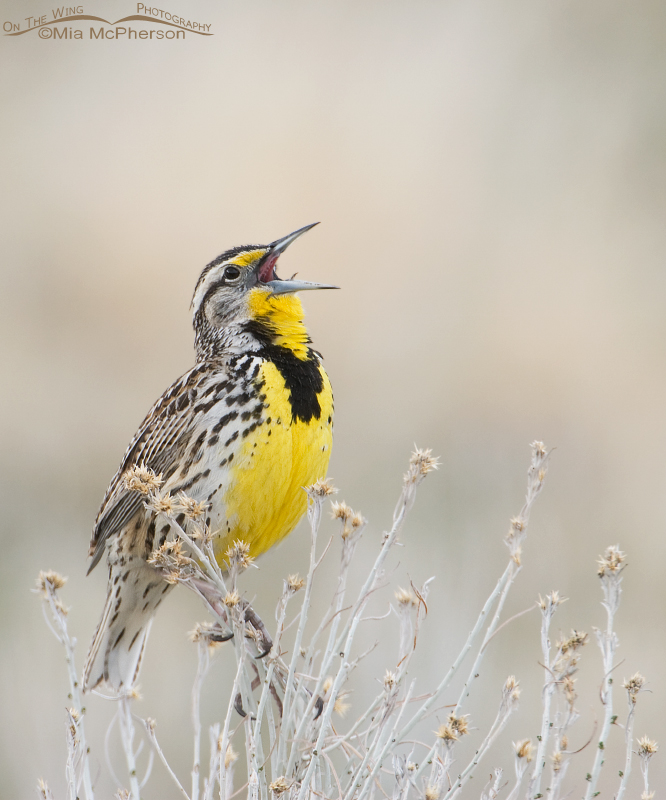 Western Meadowlark (Sturnella neglecta) singing in early spring (low light) – Nikon D200, f6.3, 1/160, ISO 400, +1.0 Nikkor 200-400mm VR with 1.4x TC at 400mm
Western Meadowlark (Sturnella neglecta) singing in early spring (low light) – Nikon D200, f6.3, 1/160, ISO 400, +1.0 Nikkor 200-400mm VR with 1.4x TC at 400mm
I don’t believe I have ever made a visit to Antelope Island without hearing or seeing Western Meadowlarks. Ever. During breeding season they seem unable to stop singing, you can tell they are trying to not sing but it just bursts forth anyway. And when they are feeding nestlings it is not uncommon to see them with 25 or more bugs in their bills. I don’t know how they don’t drop them all.
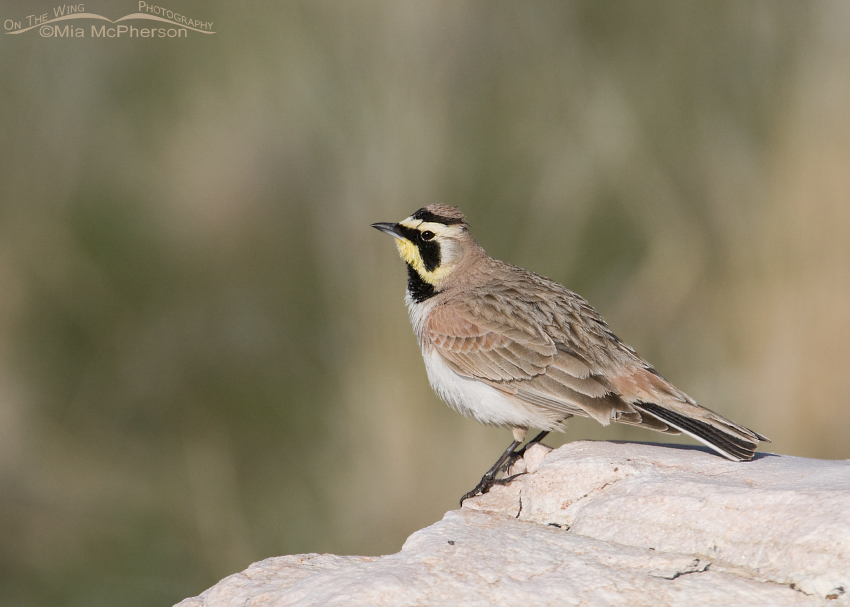 Male Horned Lark (Eremophila alpestris) – Nikon D200, f6.3, 1/2000, ISO 400, Nikkor 200-400mm VR with 1.4x TC at 400mm
Male Horned Lark (Eremophila alpestris) – Nikon D200, f6.3, 1/2000, ISO 400, Nikkor 200-400mm VR with 1.4x TC at 400mm
Horned Larks are also year round residents on the island, they delight me with their soft calls while perched on rocks and in flight. I love their subtle coloration, the little bit of yellow on their faces and those tiny little horns. They can be seen out in the open, feeding in the grasses, perched on signs and singing from the top of boulders that dot the island. I can’t resist taking photos of them.
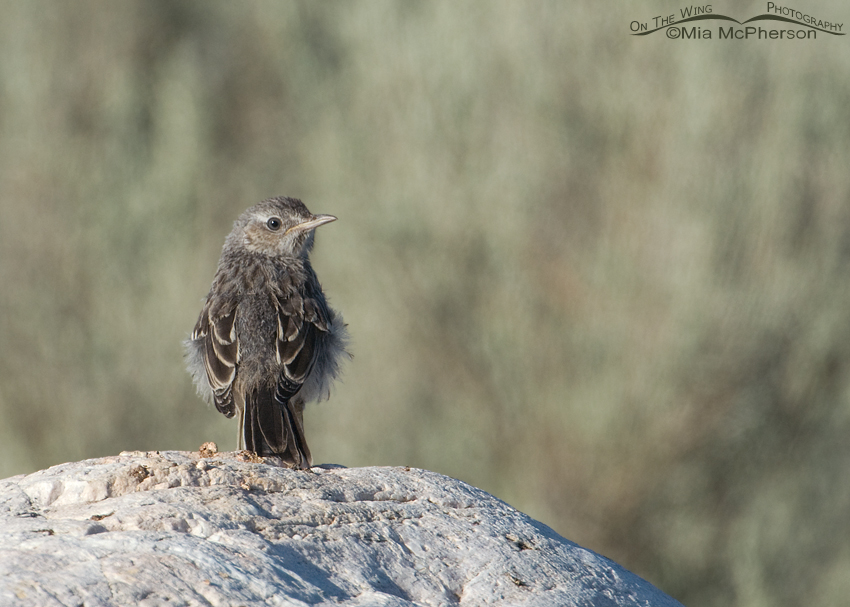 Sage Thrasher (Oreoscoptes montanus) juvenile – Nikon D200, f9, 1/500, ISO 400, Nikkor 200-400mm VR with 1.4x TC at 400mm
Sage Thrasher (Oreoscoptes montanus) juvenile – Nikon D200, f9, 1/500, ISO 400, Nikkor 200-400mm VR with 1.4x TC at 400mm
Sage Thrashers are part-time residents of Antelope Island that breed and nest during the summer. Some years they show up in large numbers while other years there just aren’t as many. I love to see them flitting from one sage brush to another or perched on the boulders like the juvenile shown above. I miss them during the winter but I know I’ll get to see them again soon.
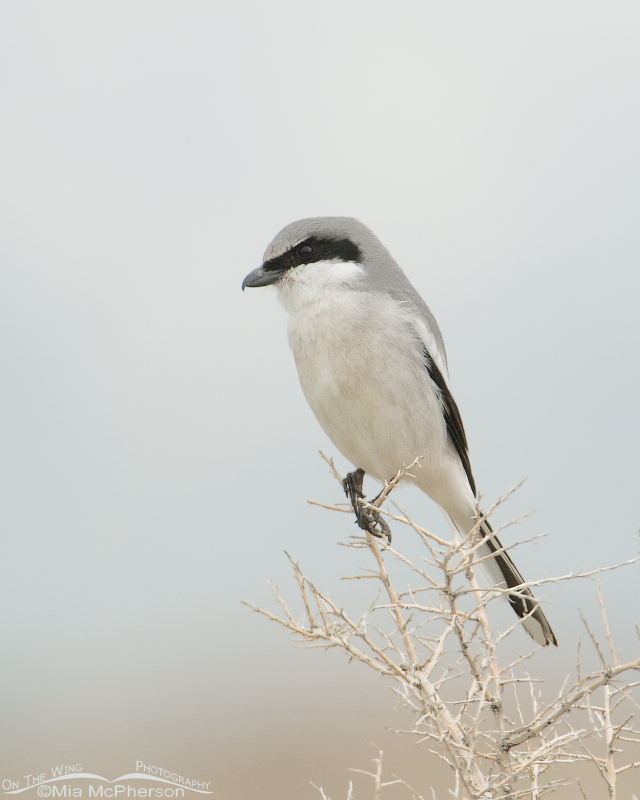 Perched Loggerhead Shrike (Lanius ludovicianus) in low light – Nikon D200, f6.3, 1/1000, ISO 400, +0.7 EV, Nikkor 200-400mm VR with 1.4x TC at 400mm
Perched Loggerhead Shrike (Lanius ludovicianus) in low light – Nikon D200, f6.3, 1/1000, ISO 400, +0.7 EV, Nikkor 200-400mm VR with 1.4x TC at 400mm
I am always tickled to see Loggerhead Shrikes on the island and normally I hear them just before I see them. They are classified as “songbirds” and they really do sing but to me they look and act like small raptors. They are fierce, aggressive and very interesting birds. During the winter their cousins; the Northern Shrikes can also been seen on the island, this winter I have seen a few but too far away to get decent images of them.
There are sparrows, doves, warbler, wrens, vireos, tanagers and many more perching birds that live on or visit Antelope Island, it is such a bird magnet!
Pelicans:
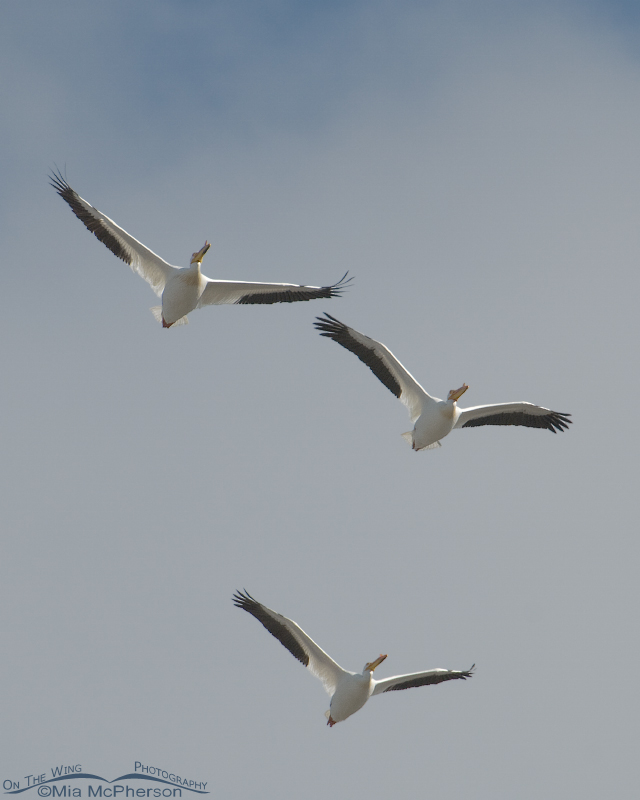 American White Pelicans (Pelecanus erythrorhynchos) in flight – Nikon D200, f7.1, 1/1000, ISO 250, Nikkor 200-400mm VR with 1.4x TC at 400mm
American White Pelicans (Pelecanus erythrorhynchos) in flight – Nikon D200, f7.1, 1/1000, ISO 250, Nikkor 200-400mm VR with 1.4x TC at 400mm
American White Pelicans breed in the Great Salt Lake area and it isn’t uncommon to see large flocks of them soaring in the thermals on clear days. These are huge birds with wingspans of up to 108 inches, nearly 30 inches longer than their relative the Brown Pelican. They are graceful and beautiful in flight.
Their cousins; the Double-crested Cormorants, are also seen in flight over the island from about March until late fall.
Ducks and Grebes:
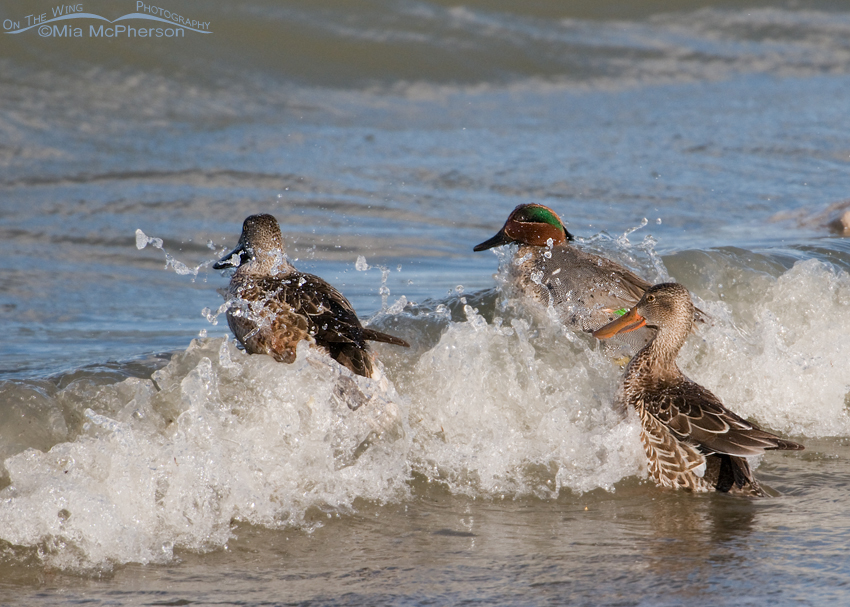 Green-winged Teal with Northern Shovelers in the surf of the Great Salt Lake – Nikon D300, f6.3, 1/2000, ISO 640, Nikkor 200-400mm VR with 1.4x TC at 400mm
Green-winged Teal with Northern Shovelers in the surf of the Great Salt Lake – Nikon D300, f6.3, 1/2000, ISO 640, Nikkor 200-400mm VR with 1.4x TC at 400mm
Swans, geese and many species of ducks can be found in the waters of the Great Salt Lake and nearby freshwater marshes, I counted 29 of them on the bird checklist for Antelope Island. Autumn and winter is awesome for seeing ducks along the causeway which sometimes number well over thousands within plain view.
For my Florida friends: yes, we actually get surf on the Great Salt Lake when the winds are strong and our ducks seem to enjoy surfing!
Other water birds that can be seen on the lake are five species of Grebes, American Coots and occasionally Common Loons.
Hawks, Eagles and Falcons:
 Northern Harrier (Circus cyaneus) male in flight – Nikon D300, f9, 1/1000, ISO 640, +1.3 EV, Nikkor 200-400mm VR with 1.4x TC at 400mm, not baited
Northern Harrier (Circus cyaneus) male in flight – Nikon D300, f9, 1/1000, ISO 640, +1.3 EV, Nikkor 200-400mm VR with 1.4x TC at 400mm, not baited
Antelope Island State Park is home year round for Golden Eagles and Bald Eagles are a common sight during the winter with fly overs and Bald Eagles sitting on the ice of the Great Salt Lake. Northern Harriers are year round residents that cruise along the causeway to the island, near the shorelines and over other areas of the island itself. Northern Harriers prefer voles as their diet and there must be plenty of those around to support the numbers of harriers that I have seen.
Osprey are seen flying over the island during migration, they don’t fish in the Great Salt Lake because it is too saline for fish to live in but they do fish in the surrounding freshwater marshes and ponds.
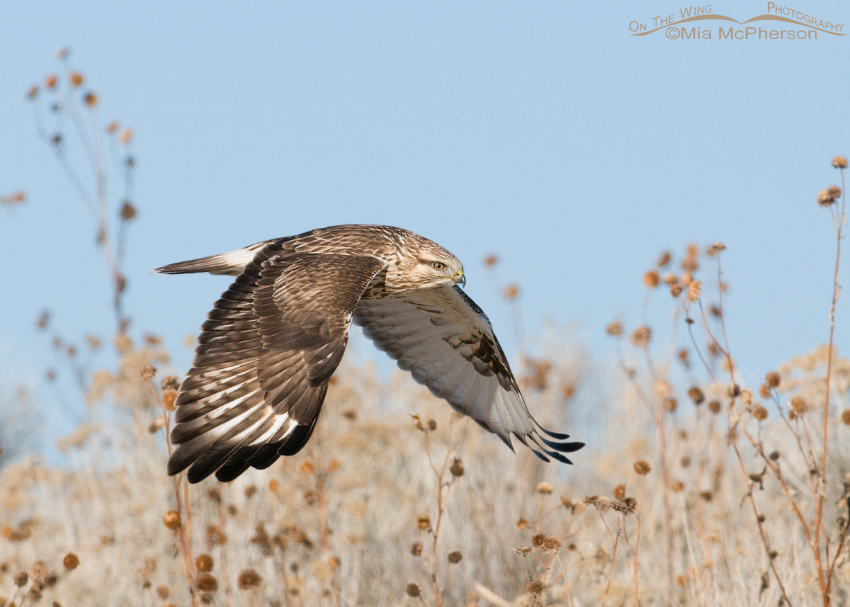 Rough-legged Hawk (Buteo lagopus) in flight – Nikon D300, f6.3, 1/2500, ISO 640, +0.3 EV, Nikkor 200-400mm VR with 1.4x TC at 285mm, not baited
Rough-legged Hawk (Buteo lagopus) in flight – Nikon D300, f6.3, 1/2500, ISO 640, +0.3 EV, Nikkor 200-400mm VR with 1.4x TC at 285mm, not baited
Rough-legged Hawks have been plentiful on the island this winter and I have been overjoyed with that happening. I have been able to observe them hunting, hovering, eating, perching, having aerial fights with each other, swooping towards their prey and in flight. I have learned much more about this species habits because they have been so abundant.
Other hawks that are found on the island include Sharp-shinned, Cooper’s, Red-tailed and Swainson’s Hawks.
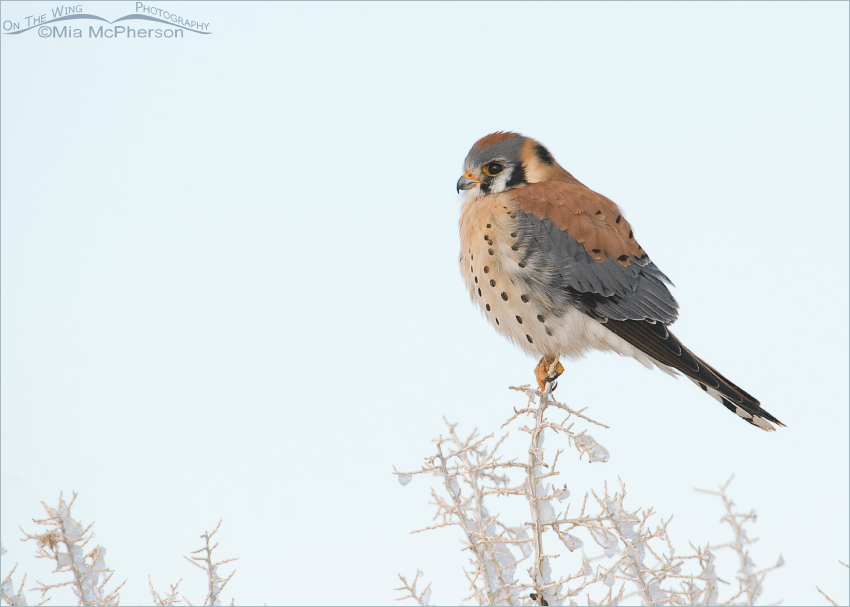 American Kestrel (Falco sparverius) male – Nikon D200, f7.1, 1/350, ISO 400, +1.0 EV, Nikkor 200-400mm VR with 1.4x TC at 400mm, not baited
American Kestrel (Falco sparverius) male – Nikon D200, f7.1, 1/350, ISO 400, +1.0 EV, Nikkor 200-400mm VR with 1.4x TC at 400mm, not baited
Then there are the Falcons of Antelope Island. This beautiful little American Kestrel male was perched on a snow covered shrub while keeping an eye on me. They are the smallest falcon in North America but I don’t think they know that, I’ve seen them dive bombing much larger birds than themselves. Feisty and small, that is what my mother used to say about me.
 Peregrine Falcon (Falco peregrinus) on prey in low light – Nikon D300, f7.1, 1/200, ISO 640, -0.3 EV, Nikkor 200-400mm VR with 1.4x TC at 400mm, not baited
Peregrine Falcon (Falco peregrinus) on prey in low light – Nikon D300, f7.1, 1/200, ISO 640, -0.3 EV, Nikkor 200-400mm VR with 1.4x TC at 400mm, not baited
Peregrine Falcons are permanent residents of the Antelope Island area, during warmer months they often feed on a variety of shorebirds and during the winter they eat ducks like this Northern Shoveler. Inflight they are very challenging to photograph because they fly so fast. This falcon wasn’t bothered by my presence as it ate but it did keep an eye on me at times.
 Perched 1st year Prairie Falcon on the shore of the Great Salt Lake – Nikon D300, f6.3, 1/2000, ISO 640, +0.3 EV, Nikkor 200-400mm at 400mm, not baited
Perched 1st year Prairie Falcon on the shore of the Great Salt Lake – Nikon D300, f6.3, 1/2000, ISO 640, +0.3 EV, Nikkor 200-400mm at 400mm, not baited
Prairie Falcons are another year round resident of the area and I have had a great time this winter photographing them. Until this winter they were a nemesis bird for me, always too far away to get good photographs of, but they are a nemesis no more.
Merlins are seen during the winter on the island and the causeway, I’m still working on getting some images of them from the Antelope Island area.
Owls:
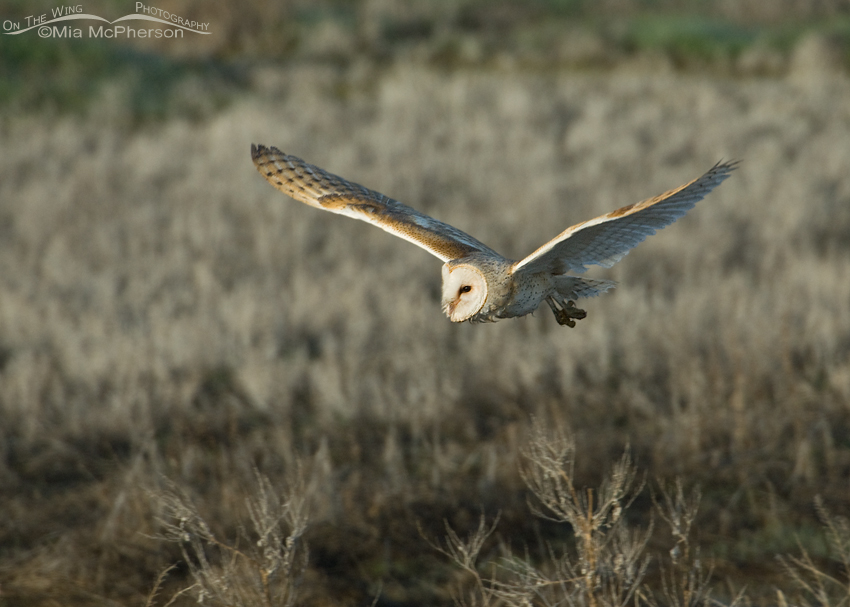 Adult Barn Owl (Tyto alba) in flight – Nikon D200, f6.3, 1/640, ISO 400, Nikkor 200-400mm VR with 1.4x TC at 400mm, not baited
Adult Barn Owl (Tyto alba) in flight – Nikon D200, f6.3, 1/640, ISO 400, Nikkor 200-400mm VR with 1.4x TC at 400mm, not baited
Barn Owls nest on the island and nearby locations, when the adults are feeding chicks they can be seen in flight during daylight. When we have a hard winter (and this year we are not) they can be seen hunting all day long. This Barn Owl was hunting near the beginning of the causeway to the island which is marshy and it has the mud on its feet from pouncing on prey.
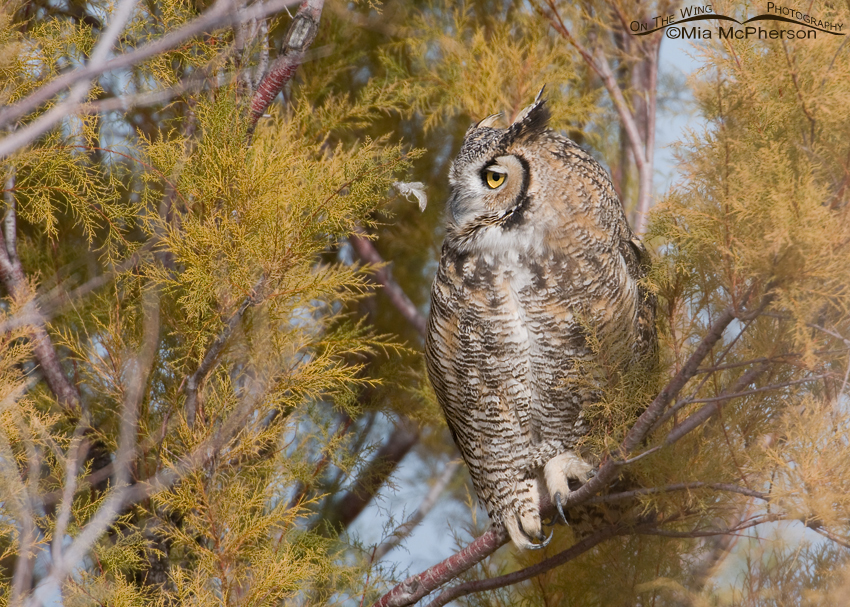 Great Horned Owl (Bubo virginianus) adult – Nikon D300, f6.3, 1/1000, ISO 400, Nikkor 200-400mm VR with 1.4x TC at 400mm, not baited
Great Horned Owl (Bubo virginianus) adult – Nikon D300, f6.3, 1/1000, ISO 400, Nikkor 200-400mm VR with 1.4x TC at 400mm, not baited
Great Horned Owls can be seen and photographed in several locations on the island and are permanent residents. Since I was a child I have always been fascinated by Great Horned Owls so I am always thrilled to have an opportunity to photograph them.
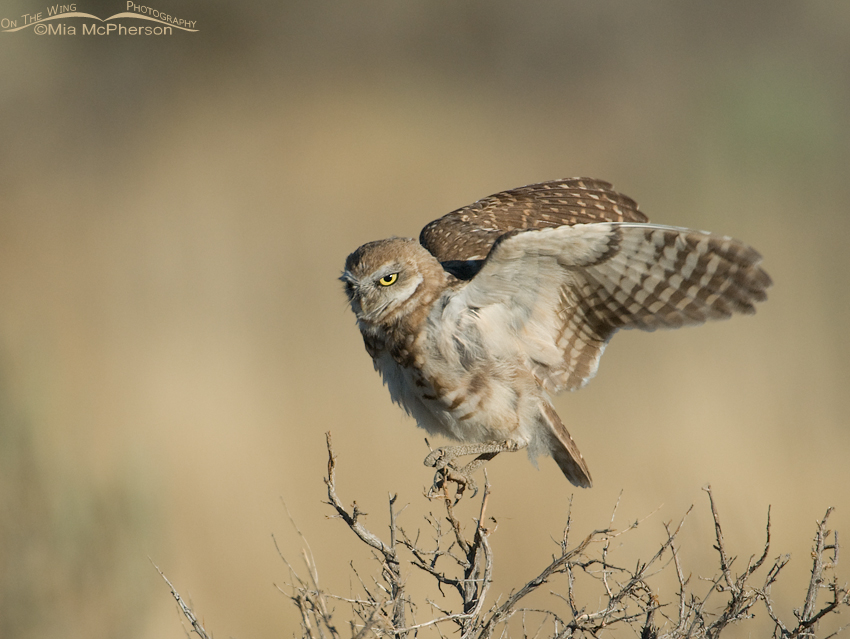 Juvenile Burrowing Owl (Athene cunicularia) flapping its wings – Nikon D200, f6.3, 1/1600, ISO 400, Nikkor 200-400mm VR with 1.4x TC at 400mm
Juvenile Burrowing Owl (Athene cunicularia) flapping its wings – Nikon D200, f6.3, 1/1600, ISO 400, Nikkor 200-400mm VR with 1.4x TC at 400mm
I simply adore Burrowing Owls, they are little, cute, funny and stunningly beautiful. They are a pleasure to photograph and because they are often very animated it can be hilarious too. I have had to hold my breath to squelch my laughter at times just so my camera and lens wouldn’t shake.
Other Owls that are seen on Antelope Island are Short-eared and Long-eared Owls. Northern Saw-whet Owls have also been seen and this winter there was a Snowy Owl reported along the causeway which turned out to be “A One day Wonder”, I would have loved to have a few images of that visitor from the Great White North. Maybe another year.
There are other birds of Antelope Island whose images aren’t here, there are simply too many for a blog post. Perhaps I should create a book.
Thanks for looking at the series of images and reading my thoughts from Wild and Wonderful ~ Antelope Island State Park!
Mia
* If you are in the Great Salt Lake Area during the month of May you may want to consider visiting the Great Salt Lake Bird Festival which includes events on Antelope Island State Park. For more information please click on the graphic below.



[…] Participate in seasonal birdwatching events […]
Mia…..your photography is so beautiful!!! You have caught some incredible shots! I just happened by looking for the name of the small birds who are guarding the entrance to the visitor’s center at Antelope Lake Utah. Thank you for sharing your beautiful work and obviously your passion. So, beautiful.you can even see the personalities under those feathers.
Pat Ross Ahwatukee AZ
Hi! You have such beautiful bird images! I’m somewhat of a newcomer to bird photography but am HOOKED on it; right now my focus is on making better use of light when photographing them — “good” light makes such a difference! Your images definitely reflect that (small pun )! Anyway, thanks to your link to the Salt Lake Bird Festival, which I’m now considering attending, I’m wondering what “field trips” or workshops you would recommend as “must dos”? I’ll be driving up from Las Vegas and want to get in as much bird & wildlife photography as possible. I shoot mostly with a 150-500mm lens and crop sensor so can be a little ways away (although closer is even better!). Thanks, and I look forward to seeing even more of your images!
)! Anyway, thanks to your link to the Salt Lake Bird Festival, which I’m now considering attending, I’m wondering what “field trips” or workshops you would recommend as “must dos”? I’ll be driving up from Las Vegas and want to get in as much bird & wildlife photography as possible. I shoot mostly with a 150-500mm lens and crop sensor so can be a little ways away (although closer is even better!). Thanks, and I look forward to seeing even more of your images!
Suzanne, I’d look for the list of events at the Salt Lake Bird Festival and register as soon as possible, those events fill up fast! Be sure to visit Antelope Island SP, Bear River NWR and Farmington Bay WMA when you are here. I haven’t checked to see what events or workshops are listed yet. You’ll be able to get close enough with your lens.
Thank you so much for your kinds comments on my work. I love what I do and my subjects too!
I have my fingers poised over the keyboard to register, however the event people haven’t opened up for it yet. But I did see field trips listed for the places you mentioned and I absolutely will try to make it to those locales — sounds awesome.
But I did see field trips listed for the places you mentioned and I absolutely will try to make it to those locales — sounds awesome.
I accidentally came across your website, very nice images I must say.
I plan to visit Antelope Island next May on my way up north to Yellowstone.
Just wondered if there will be many birds around to photograph that time of year ?
just wondering if you have a suggestion of a place on AI to best observe the burrowing owls?
Jan, at this time of the year I see very few Burrowing Owls. During warmer months there are burrows down the hill from the visitors center where the owls can usually be seen.
What a WONDERFUL series!!! Fantastic, especially love, love, love close up of curlew…you get some really great close ups!
I love your photos. I would love to see an owl in the wild. Any suggestions?
I have a 400mm lens so I can get them from a distance.
Some of the best photos are those that we don’t realize we took. I spent ten minutes photographing a
Kestrel and did not realize she was digging in the snow for a mouse until I got home. Great shot, but
didn’t know I had it!!
Hello, just stumbled on your site, while trying to identify a flock of 18 large gray striped birds.. They seem so lost and out of place. Thanks to your photos… think they are Meadow larks… Can’t recall ever seeing them here this time of year ( Torrey Utah) Really appreciate your photos.. and your approach to the photos.
Reda,
I am glad you found my site and for letting me know that it helped to ID the birds you saw!
Thank you for visiting!
Your Raptors are amazing. Love the Owls. I guess I’ll have to put Antelope Island on my bucket list as well.
Just love your photography,,,,,,The Mag-pie above is simply outstanding,,,Actually they all are but the Mag-pie is just my fav. I had never thought of taking a trip to your part of the country until seeing you photos,,,,,on my bucket list now! Keep up the good work,,,I enjoy your work so much! Am also enjoying you work on NatureShare.
Thank you Roy! Magpies are common here but I photograph them every chance I get because I find them to be beautiful and fascinating. I hope that you get to Utah one day and are able to photograph on Antelope Island!
Mia, I just love your photos – so beautiful! Jana
Thank you very much Jana!
Mia! this is wonderful! As always, thanks for posting!!!
Thank you very much Jaimi, as you know, the island is a fantastic location!
Mia!
Mia!
Mia!
GREAT pics!!
I can’t pick a fave!
Thank you, thank you, thank you Judy!
Mia, your bird shots are wonderful!!
Thank you very much Judy! Our subjects are wonderful!